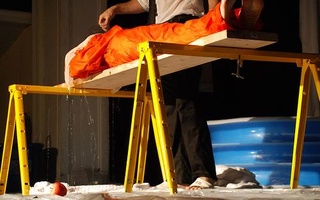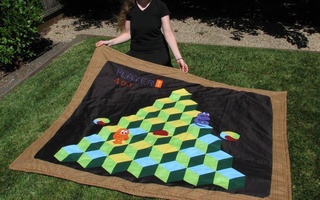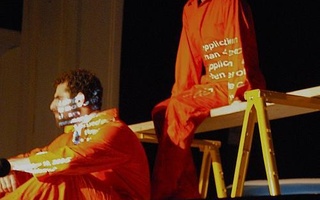FEATUREThe World Wrestling Federation may seem like a uniquely contemporary phenomenon, but anyone who's looked at theatrical history knows that staged depictions of violence are far from new. In order to better understand the dramatic roots of the World Wrestling Federation--its literary ancestry, if you will--we talked to Ayanna Thompson, a fifth-year graduate student in the Harvard English Department who studies dramatic depictions of torture in Renaissance and Restoration England.
The Harvard Crimson: Welcome, Ayanna. Can you give our readers a general overview of the history of stage torture as you understand it?
Ayanna Thompson: Well, stage torture really begins during the Restoration. It seems that in the Renaissance they didn't have a lot of depictions of torture on stage. They followed more of the classical idea that you don't show violence on stage. If you think about Shakespeare's plays, for example, there are very few violent scenes on stage--with, of course, the exception of war scenes, suicide, and murders. But no actual torture.
THC: What about the scene in King Lear where Gloucester's eyes are gouged out?
AT: Gloucester's eyes are the one big exception to that rule. But it's a rather strange scene of torture because they're not trying to get any information from him and they don't use any torture devices. It's a spontaneous moment of violence. But in the Restoration time period, from 1660 to 1700, someone must have developed a stage rack because it's all the rage in Restoration dramas--the tragedies and not the comedies. They're filled with scenes where someone will get racked on stage. It's still uncertain exactly when this stage rack came about or who built it, but it appears to be part of a general trend in the Restoration to outdo the Renaissance. Restoration playwrights were constantly rewriting Renaissance texts and there was a general turn towards depicting more things on stage, including torture.
THC: How did this reflect violence in the culture? During the Renaissance at least, there were public executions, particularly drawings and quarterings. Were these still a part of Restoration culture?
AT: Public executions were still a part of Restoration culture, but executions and torture are very different. Executions were going on a lot during the Restoration, but torture was another case. Even during the Renaissance, there weren't actually any legal processes to torture people in England unless the monarch or the privy council gave a specific order for a specific torture of a specific person for one time.
While there were lots of violent aspects of the culture and lots of horrible executions that seemed torturous because they could last for days, there was very little actual torture even then. And torture in England in this specified definition actually ended in 1640. There were the most tortures under Queen Elizabeth; she wrote the most writs for individual tortures. But there was a sudden turn against the idea of torture so that in the Restoration there was lots of violence but very little torture.
And then suddenly, once it had been outlawed, torture began showing up on stage. It seems like as soon as torture stopped occurring in society, it became safe to depict it on stage.
THC: Were these depictions of torture a big draw for audiences?
AT: We havent found any letters or articles or diary entries that say, "Oh, we went to see this great torture scene today," but stage torture was probably popular in the same way that activities like bear baiting were popular, as violent displays that appealed to the masses.
THC: What were the other sorts of violent displays that were going on at the time?
AT: There was bear baiting, where a bear would be let loose in an amphitheater-like setting and several men would try to attack it. It was a type of bull fighting but with a bear. And there's speculation that there were a few famous bears in Renaissance England and that Shakespeare's most famous stage direction--exit, pursued by a bear--refers to the use of one of these famous bears. Public executions were also very popular at the time, as were displays of traitors heads on the Tower of London and along Tower Bridge.
THC: So, to switch gears a little, have you ever watched the World Wrestling Federation?
AT: I haven't, though I suppose I'm familiar with it. When I'm on line in the supermarket, I always see on the covers of TV Guide these big, buxom blondes and then it says something about WWF. So I imagine an element of sexiness is combined with violence.
THC: As someone who studies stage violence, how do you view something like WWF, particularly in the context of contemporary culture?
AT: Well, there seems to be an attempt to curb violence in our culture, although were still a gun-toting country. And this is an outlet for violence that is safe and legal and a way to enjoy violence in a public arena, something we can't normally do since we don't have staged executions yet (though I imagine someday we will on TV).
This is one way to sanction the desire to look and to see violence and to see people hurt. And also, it has this strange soap opera edge to it. So it seems to appeal across different lines in society. There's a narrative element to it, not just violence.
THC: Do you see it as a conservative force, socially speaking?
AT: I think it can be seen both ways: as very conservative and also as a subversive element in society. The idea seems to be that you go home and practice these moves on your little brother. So in a way it shows you how to unleash this real anger that you have inside of you when your brother says something nasty to you--now youve got this move, a body-slam or something. In some ways it sanctions that sort of violence, but in other ways it's an attempt to focus your energy into being the spectator instead of the participant.
THC: If we can go back to the Restoration for a second, at what point did stage depictions or torture actually stop?
AT: After the Restoration, the Comedy of Manners took over as the dominant form of drama, so theater began to focus more on language and wit and there was less brute physicality. Think about the precursors to the Oscar Wilde-type play, where it's all about the aristocracy sitting around pontificating about how wealthy and bored they are. Throw some torture in there and it just wouldn't work.
THC: Was there a definite ending point for stage torture or was it more of a gradual transition?
AT: It was a gradual transition. The Restoration comedies were very different than the Restoration tragedies. You can already see in them the beginnings of the Comedy of Manners. The comedy vein of Restoration drama just seemed to last longer than the tragedy vain, which simply lost popularity and died off. If you've seen the stage rack once or twice or ten times, it loses its effectiveness whereas each witty language play is quite different and can keep your interest longer.
THC: Was there any force after the Restoration that fulfilled the social need--if in fact there is one--to see staged depictions of violence?
AT: Well, the stage itself became very different after the Restoration. Instead of these big public arenas for all the classes, it was removed into the wealthy homes. Lord and Lady So-and-So would decide to have a play put on in their home, and they probably didn't want the stage rack dragged into their living room.
And there was very little of a repressive element for them to feel a need to react to. So part of the shift towards the comedy of manners was due to the shift towards the home, which necessarily eliminated these fantastic--as in fantastical--torture devices.
THC: But it seems that now people are bringing very violent performances into their homes through the television.
AT: At the same time, however, the violence is staged in a public arena, and arenas tend to cross economic and even gender lines in a way that home performances don't. In some ways, WWF acts both ways: you watch it on TV but it's also in a public arena. And it even travels around so that it becomes a sort of court, a sort of "for the people" activity. If you remove it into a more private space--say, now it's going to be at the Kennedy Center--it's going to be quite different.
THC: So if you could predict the future of WWF based on your knowledge of trends of stage violence in the past, what would it be?
AT: These desires to watch something violent and to watch something that you know is fake but that pretends to be real at the same time, these desires seem to be natural.
But whether your society allows this to continue--not just legally but culturally--ebbs and flows naturally. There are times when its very popular and times when its completely unpopular, when we remove back to the comedy of manners. So stage violence in general is an ill-fated form of entertainment. It never just keeps going.
Read more in Arts
Life on the High-WireRecommended Articles
-
 A Tortured Affair
A Tortured Affair -
 New Courses, New You
New Courses, New You -
 A Tortured Affair
A Tortured Affair -
Atul Gawande Criticizes Supermax PrisonsSupermax prisons, which are designed to hold prisoners in prolonged and strict solitary confinement, are ineffective, expensive, and detrimental to mental health, surgeon and journalist Atul Gawande said during a speech at Harvard Law School yesterday.
-
Change We Can Believe In?Some people ask whether terrorists should have rights. But there is no way to tell who is a terrorist and who isn’t without some sort of fair process.
-
POSTCARD: In the Heart of DarknessIt is impossible to describe the feeling of listening to someone praise a man who was responsible for the torture and death of thousands of Chilean citizens during his brutal 17-year regime.













